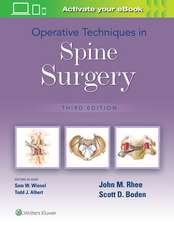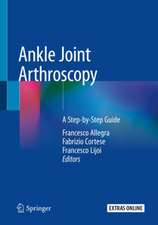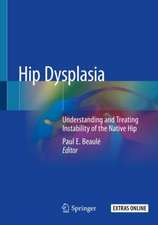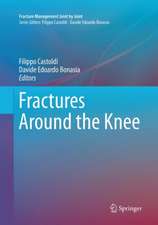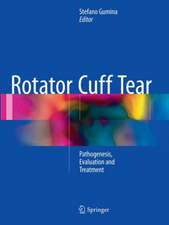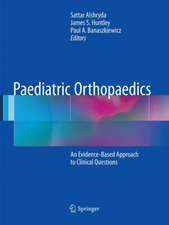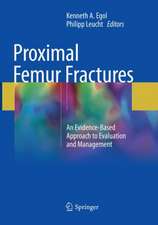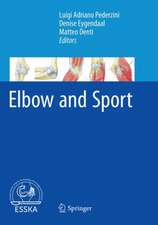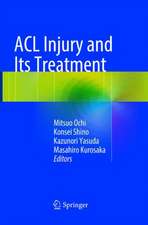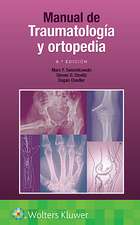Hexapod External Fixator Systems: Principles and Current Practice in Orthopaedic Surgery
Editat de Marco Massobrio, Redento Moraen Limba Engleză Paperback – 2 iun 2022
Each chapter addresses a specific Orthopaedic problem and includes representative clinical cases commented on by the authors. Illustrations and X-ray images support the discussion of the various themes treated in the textbook. Special attention is also given to deformity morphology and the consequent geometry of correction, as well as economical aspects and the biological risks of radiation exposure. A review of current nomenclature in external fixation is also provided as a quick-reference resource.
Offering clear and straightforward descriptions of these devices and their current use in practice, prepared by leading international experts, this book will benefit expert surgeons and residents alike.
| Toate formatele și edițiile | Preț | Express |
|---|---|---|
| Paperback (1) | 786.90 lei 6-8 săpt. | |
| Springer International Publishing – 2 iun 2022 | 786.90 lei 6-8 săpt. | |
| Hardback (1) | 1113.46 lei 3-5 săpt. | |
| Springer International Publishing – iun 2021 | 1113.46 lei 3-5 săpt. |
Preț: 786.90 lei
Preț vechi: 828.31 lei
-5% Nou
Puncte Express: 1180
Preț estimativ în valută:
150.59€ • 156.64$ • 124.32£
150.59€ • 156.64$ • 124.32£
Carte tipărită la comandă
Livrare economică 14-28 aprilie
Preluare comenzi: 021 569.72.76
Specificații
ISBN-13: 9783030406691
ISBN-10: 3030406695
Pagini: 311
Ilustrații: XII, 311 p. 195 illus., 157 illus. in color.
Dimensiuni: 178 x 254 mm
Greutate: 0.62 kg
Ediția:1st ed. 2021
Editura: Springer International Publishing
Colecția Springer
Locul publicării:Cham, Switzerland
ISBN-10: 3030406695
Pagini: 311
Ilustrații: XII, 311 p. 195 illus., 157 illus. in color.
Dimensiuni: 178 x 254 mm
Greutate: 0.62 kg
Ediția:1st ed. 2021
Editura: Springer International Publishing
Colecția Springer
Locul publicării:Cham, Switzerland
Cuprins
1. History and evolution of hexapod external fixators.- 2 Principles of hexapod external fixators functions: software and hardware.- 3 Characteristics and usage modalities. Main systems.- 4 Hexapod external fixators in acute fracture treatment and their complications.- 5 Hexapod external fixators in the treatment of axial and rotation deformities and limb length discrepancies.- 6 Hexapod external fixators in bone defect treatment.- 7 Hexapod external fixators in pediatric deformities.- 8 Hexapod external fixators in articular stiffness treatment.- 9 Hexapod external fixators in foot deformity correction.- 10 Problems, challenge, complications in hexapod external fixation systems. Contraindications.- 11 Hexapod external fixators upgrade: motor powered frames , automation, deformity correction scheduling and remote control.- 12 Ancillary usage of hexapod external fixators: Fixator assisted nailing (FAN), fixator assisted locking plate (FALP), lenghtening over nail (LON), bone transport over a nail (BTON) and lenghtening and then nailing (LATN). External to internal fixation conversion timing.- 13 Ionizing radiation exposure.- 14 Economical aspects and practical considerations.- 15 Appendix: Deformity geometry.- 16 Nomenclature.
Notă biografică
Marco Massobrio is an Aggregate Professor of Orthopaedics and Traumatology at “Sapienza” University of Rome and the past President (years 2018-2020) of the Italian Society of External Fixation (SIFE). As Chief Surgeon of the Unit for pelvic and complex trauma of lower limbs at the Policlinico Umberto I in Rome, he has over 30 years of experience in the field of Orthopaedics and Traumatology, with a special interest in primary and secondary limb deformity correction and bone defect reconstruction, mainly by means of external fixator devices. For the past 10 years, he has been using computer- assisted hexapod external fixators for the treatment of complex deformities.
Textul de pe ultima copertă
This book provides a thorough description of hexapod external fixators, from the theoretical basis to their practical application. Indications and practical use in current Orthopaedic practice are addressed in detail, offering the reader essential insights into the strengths and limitations of these devices. The main aspects covered, include primary (congenital) and secondary (acquired) deformities of the limbs: the etiology, pathomechanics, clinics, technical “tips and tricks” and suggested frame assemblies are presented.
Each chapter addresses a specific Orthopaedic problem and includes representative clinical cases commented on by the authors. Illustrations and X-ray images support the discussion of the various themes treated in the textbook. Special attention is also given to deformity morphology and the consequent geometry of correction, as well as economical aspects and the biological risks of radiation exposure. A review of current nomenclature in externalfixation is also provided as a quick-reference resource.
Offering clear and straightforward descriptions of these devices and their current use in practice, prepared by leading international experts, this book will benefit expert surgeons and residents alike.
Each chapter addresses a specific Orthopaedic problem and includes representative clinical cases commented on by the authors. Illustrations and X-ray images support the discussion of the various themes treated in the textbook. Special attention is also given to deformity morphology and the consequent geometry of correction, as well as economical aspects and the biological risks of radiation exposure. A review of current nomenclature in externalfixation is also provided as a quick-reference resource.
Offering clear and straightforward descriptions of these devices and their current use in practice, prepared by leading international experts, this book will benefit expert surgeons and residents alike.
Caracteristici
Describes the indications, current use, strengths and limitations of hexapod external fixator systems Gathers contributions by leading international experts on the use of hexapodalic external fixators Offers detailed, systematic descriptions of primary and secondary deformities of the limbs, and their treatment using hexapod external fixators



